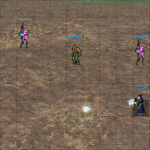3 Months of Game Development Statistics
I’m hoping make my game development process transparent as possible, so on a quarterly basis I plan to publish some figures related to productivity, marketing, code count, and anything else that may be relevant to other game developers out there. So without further ado, here are some stats related to my first three months of game development.
Productivity Stats
I use RescueTime to track my productivity, and I worked a total of 261 hours over the past three months. My monthly “productivity pulse” varied between 75 and 85 percent and about 50% of my time was spent on software development, 14% on learning, and 14% on business. I’m pretty happy with my work in April and May, but June was a bit of a disaster. Vacation, burnout, and the World Cup were the culprits, but I’m confident that can be turned around in July.

Twitter Stats
I didn’t use Twitter prior to this competition and I had zero followers to start with. I’ve grown my follower base to about 270 now and the growth looks to be fairly steady. There are probably a number of things I can do to increase my readership, like tweeting more than .71 times per day, but I’ll be happy if the current trend continues and I reach 1000 followers before my game launches.


Google Analytics Stats
Our readership shows a bit of a downward trend at first that can be attributed to an early bump due to press and Hacker News at the start of our competition. We’ve slowly started to gain a little traction after that, which can largely attributed to the Corona and Swift communities. We know that building a readership takes time and we’re going to keep plugging away.
Code Stats
The Mythical Man Month states that the average programmer will produce about 10 lines of code per day, but as all programmers know, you can’t exactly tell how much work is being done by how much code is written. You can inflate your code count by writing crappy code. You can also be productive without coding while prototyping, testing, and refactoring, all which do not add to the final code count. For a solo indie dev, other productive uses of time like blogging, design and marketing further take away from development time.
That being said, it’s still interesting to follow how much code goes into a project. So far I have written about 3500 lines of code when you exclude the external libraries and the files associated with sprite data. I’ve been on my work computer for 261 hours, which puts my net code count at 13.4 lines per hour. If I’m logged into the computer for about 6 hours a day, then I’ve worked on this project for 43 days and produced about 81 lines of code per day. About 64% of my time was spent on software development and learning, so I could theoretically double(ish) those numbers if I only had to focus on programming.
I’m not really sure what to expect in the future as far as code count goes. On one hand, it should rise since I don’t have to trash as much code learning how game development works and constantly refactoring code. On the other hand, once a game loop is written, much of what I’ll be doing is creating content and play testing the game itself. Whatever the count may be, I’ll be happy as long as the game continues to progress.
Game State
The most important part of game development is actually developing a game and the images below tell the tale of how my prototype has progressed over the last couple of months.










Thank you
Your comment will be published once it has been approved.
to see the pull request you generated.